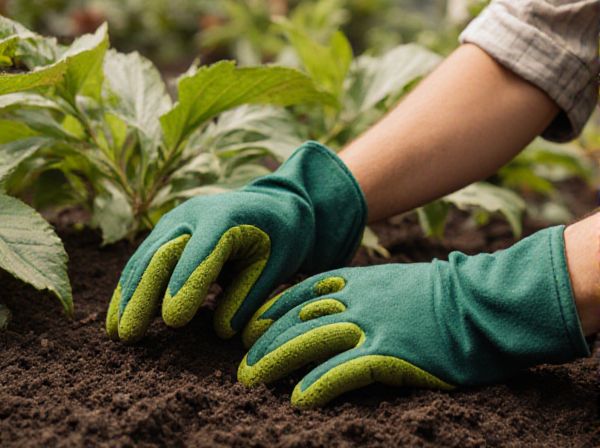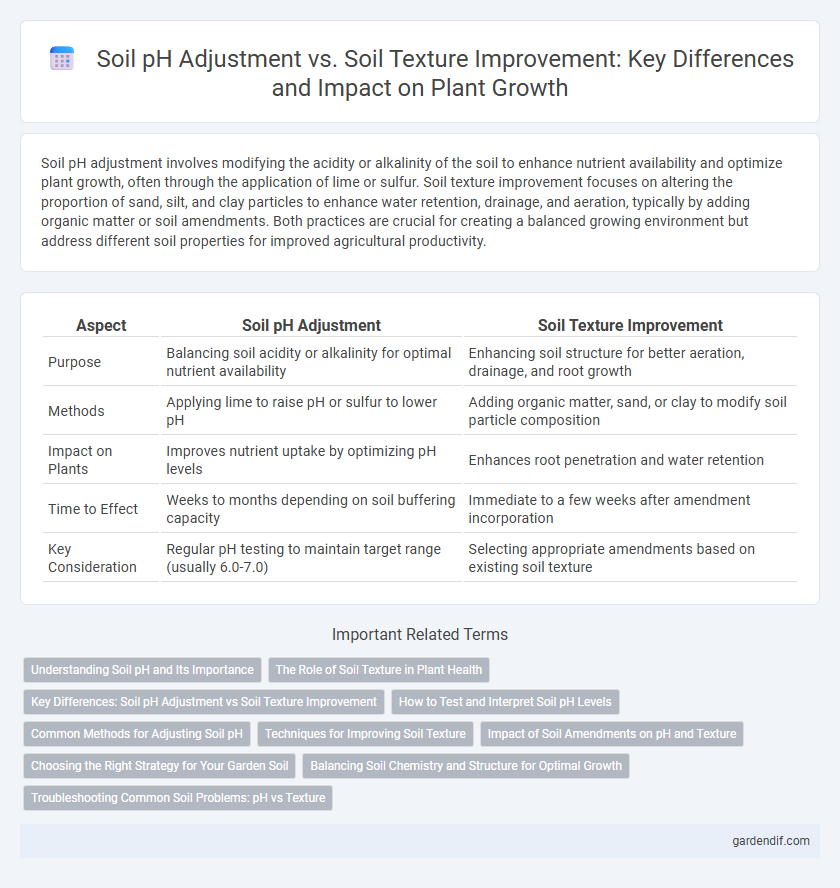
Soil pH Adjustment vs Soil Texture Improvement Illustration
Soil pH adjustment involves modifying the acidity or alkalinity of the soil to enhance nutrient availability and optimize plant growth, often through the application of lime or sulfur. Soil texture improvement focuses on altering the proportion of sand, silt, and clay particles to enhance water retention, drainage, and aeration, typically by adding organic matter or soil amendments. Both practices are crucial for creating a balanced growing environment but address different soil properties for improved agricultural productivity.
Table of Comparison
| Aspect | Soil pH Adjustment | Soil Texture Improvement |
|---|---|---|
| Purpose | Balancing soil acidity or alkalinity for optimal nutrient availability | Enhancing soil structure for better aeration, drainage, and root growth |
| Methods | Applying lime to raise pH or sulfur to lower pH | Adding organic matter, sand, or clay to modify soil particle composition |
| Impact on Plants | Improves nutrient uptake by optimizing pH levels | Enhances root penetration and water retention |
| Time to Effect | Weeks to months depending on soil buffering capacity | Immediate to a few weeks after amendment incorporation |
| Key Consideration | Regular pH testing to maintain target range (usually 6.0-7.0) | Selecting appropriate amendments based on existing soil texture |
Understanding Soil pH and Its Importance
Soil pH directly influences nutrient availability and microbial activity essential for plant growth, with optimal ranges typically between 6.0 and 7.5 for most crops. Adjusting soil pH through liming acidic soils or sulfur application in alkaline conditions improves nutrient uptake efficiency and reduces toxicity risks. While soil texture affects water retention and aeration, managing pH is critical for creating an environment conducive to nutrient absorption and healthy root development.
The Role of Soil Texture in Plant Health
Soil texture significantly influences plant health by determining water retention, aeration, and nutrient availability essential for root development. Unlike soil pH adjustment, which modifies chemical properties, improving soil texture involves altering particle size distribution to enhance physical conditions that support microbial activity and root growth. Properly balanced soil texture ensures optimal soil structure, leading to improved moisture regulation and nutrient uptake critical for robust plant growth.
Key Differences: Soil pH Adjustment vs Soil Texture Improvement
Soil pH adjustment involves modifying the acidity or alkalinity levels to optimize nutrient availability and promote healthy plant growth, typically through lime or sulfur applications. Soil texture improvement focuses on altering the proportion of sand, silt, and clay to enhance water retention, drainage, and aeration without changing the chemical composition. These processes serve distinct functions: pH adjustment targets chemical balance, while texture improvement addresses physical structure.
How to Test and Interpret Soil pH Levels
Testing soil pH involves collecting a representative soil sample and using a pH meter or pH test kit to measure the hydrogen ion concentration, which determines acidity or alkalinity. Interpreting soil pH values typically ranges from 0 to 14, with values below 7 indicating acidic soil, values above 7 indicating alkaline soil, and 7 being neutral; ideal pH varies by crop but generally falls between 6.0 and 7.5 for optimal nutrient availability. Understanding soil pH is essential for deciding whether to adjust acidity with lime or sulfur applications or focus on soil texture improvements like adding organic matter to enhance drainage and aeration.
Common Methods for Adjusting Soil pH
Common methods for adjusting soil pH include lime application to raise pH in acidic soils and sulfur or aluminum sulfate to lower pH in alkaline soils. These amendments alter the soil's chemical properties to optimize nutrient availability for plants. Incorporating organic matter, such as compost, also supports pH balance and improves soil buffering capacity.
Techniques for Improving Soil Texture
Improving soil texture involves techniques such as adding organic matter, incorporating sand or clay, and using cover crops to enhance soil structure and porosity. Organic amendments like compost increase water retention and nutrient availability, while sand or clay amendments adjust particle size distribution for better aeration and root penetration. Crop rotation and reduced tillage practices also promote the development of granular soil aggregates critical for optimal texture.
Impact of Soil Amendments on pH and Texture
Soil amendments such as lime and sulfur primarily influence soil pH by neutralizing acidity or alkalinity, thereby optimizing nutrient availability for plants. Organic matter addition improves soil texture by enhancing aggregation, water retention, and aeration, which promotes root growth and microbial activity. Balancing pH through amendments while improving texture ensures enhanced soil fertility and sustainable crop productivity.
Choosing the Right Strategy for Your Garden Soil
Adjusting soil pH targets chemical balance by adding lime to raise pH or sulfur to lower it, optimizing nutrient availability for plants. Improving soil texture involves incorporating organic matter or sand to enhance drainage, aeration, and root penetration, essential for healthy plant growth. Selecting the right strategy depends on soil testing results to identify whether chemical corrections or physical amendments will best support your garden's specific crop needs.
Balancing Soil Chemistry and Structure for Optimal Growth
Balancing soil pH adjustment and soil texture improvement is essential for optimal plant growth, as soil chemistry influences nutrient availability while soil structure affects root development and water retention. Acidic or alkaline soils can be neutralized through amendments like lime or sulfur, enhancing nutrient uptake, whereas improving soil texture with organic matter or sand improves aeration and drainage. Integrating both approaches ensures a harmonious environment that supports robust root systems and maximizes fertilizer efficiency.
Troubleshooting Common Soil Problems: pH vs Texture
Adjusting soil pH targets nutrient availability by neutralizing acidity or alkalinity, essential for optimal plant growth, while soil texture improvement enhances water retention and aeration by modifying sand, silt, and clay proportions. Common issues like nutrient deficiencies often stem from improper pH levels, whereas poor drainage or compaction usually relates to unsuitable texture. Effective soil management balances pH correction with texture amendment to resolve crop stress and improve yield.
Soil pH Adjustment vs Soil Texture Improvement Infographic

 gardendif.com
gardendif.com